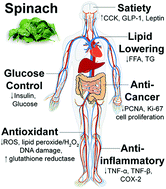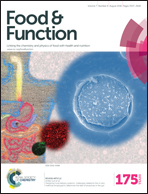Functional properties of spinach (Spinacia oleracea L.) phytochemicals and bioactives
Abstract
Overwhelming evidence indicates that diets rich in fruits and vegetables are protective against common chronic diseases, such as cancer, obesity and cardiovascular disease. Leafy green vegetables, in particular, are recognized as having substantial health-promoting activities that are attributed to the functional properties of their nutrients and non-essential chemical compounds. Spinach (Spinacia oleracea L.) is widely regarded as a functional food due to its diverse nutritional composition, which includes vitamins and minerals, and to its phytochemicals and bioactives that promote health beyond basic nutrition. Spinach-derived phytochemicals and bioactives are able to (i) scavenge reactive oxygen species and prevent macromolecular oxidative damage, (ii) modulate expression and activity of genes involved in metabolism, proliferation, inflammation, and antioxidant defence, and (iii) curb food intake by inducing secretion of satiety hormones. These biological activities contribute to the anti-cancer, anti-obesity, hypoglycemic, and hypolipidemic properties of spinach. Despite these valuable attributes, spinach consumption remains low in comparison to other leafy green vegetables. This review examines the functional properties of spinach in cell culture, animals and humans with a focus on the molecular mechanisms by which spinach-derived non-essential phytochemicals and bioactives, such as glycolipids and thylakoids, impart their health benefits.


 Please wait while we load your content...
Please wait while we load your content...